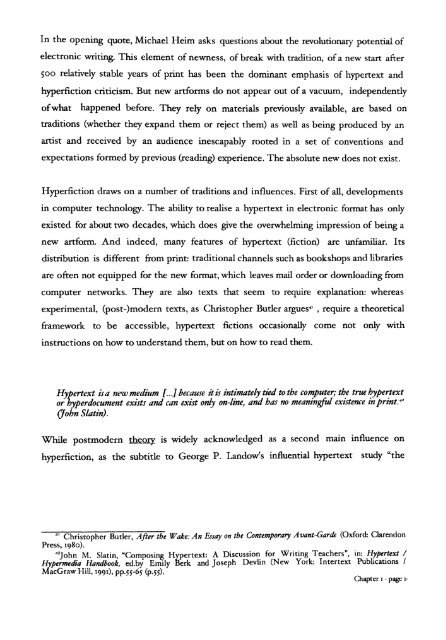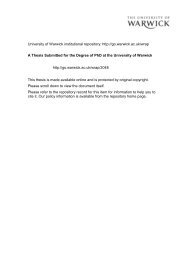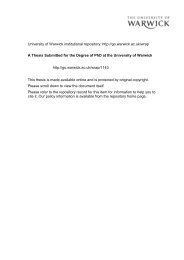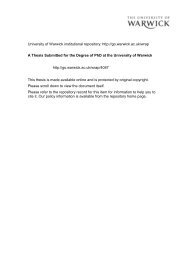From Page to Screen - WRAP: Warwick Research Archive Portal ...
From Page to Screen - WRAP: Warwick Research Archive Portal ...
From Page to Screen - WRAP: Warwick Research Archive Portal ...
You also want an ePaper? Increase the reach of your titles
YUMPU automatically turns print PDFs into web optimized ePapers that Google loves.
In the opening quote, Michael Heim asks questions about the revolutionary potential of<br />
electronic writing. This element of newness, of break with tradition, ofa new start after<br />
50 0 relatively stable years of print has been the dominant emphasis of hypertext and<br />
hyperfiction criticism. But new artforms do not appear out of a vacuum, independently<br />
ofwhat happened before. They rely on materials previously available, are based on<br />
traditions (whether they expand them or reject them) as well as being produced by an<br />
artist and received by an audience inescapably rooted in a set of conventions and<br />
expectations formed by previous (reading) experience. The absolute new does not exist.<br />
Hyperfiction draws on a number of traditions and influences. First of all, developments<br />
in computer technology. The ability <strong>to</strong> realise a hypertext in electronic format has only<br />
existed for about two decades, which does give the overwhelming impression of being a<br />
new artform. And indeed, many features of hypertext (fiction) are unfamiliar. Its<br />
distribution is different from print: traditional channels such as bookshops and libraries<br />
are often not equipped for the new format, which leaves mail order or downloading from<br />
computer networks. They are also texts that seem <strong>to</strong> require explanation: whereas<br />
experimental, (post-Imodern texts, as Chris<strong>to</strong>pher Butler argues" , require a theoretical<br />
framework <strong>to</strong> be accessible, hypertext fictions occasionally come not only with<br />
instructions on how <strong>to</strong> understand them, but on how <strong>to</strong> read them.<br />
Hypertext isa newmedium {...] because itis intimately tied <strong>to</strong> the computer; the trot hypertext<br />
or byperdocument exists and can exist only on-line, and has no meaningful existence inprint. 42<br />
(John Slatin).<br />
While postmodern theory is widely acknowledged as a second main influence on<br />
hyperfiction, as the subtitle <strong>to</strong> George P. Landow's influential hypertext study "the<br />
41 Chris<strong>to</strong>pher Butler, After the Wake: An Essay on the Contemporary Avant-Garde (Oxford: Clarendon<br />
Press, 1980).<br />
42John M. Slatin, "Composing Hypertext: A Discussion. for Writing Teachers", in: Hyptr:ext /<br />
Hypermedia Handbook, ed.by Emily Berk and Joseph Devlin (New York: Intertext Publications I<br />
MacGraw Hill, 1991) , PP·55-65 (P.55).<br />
Chapter I - page I'





